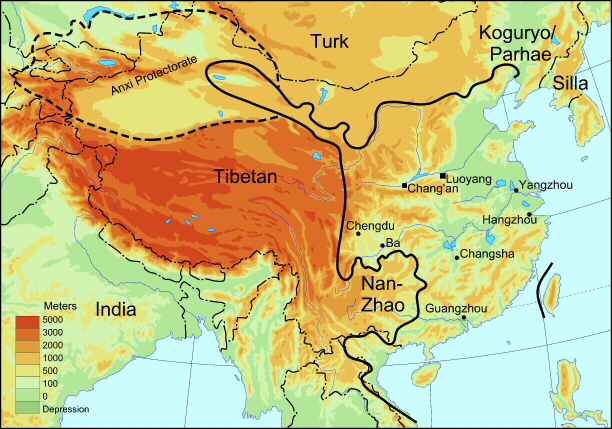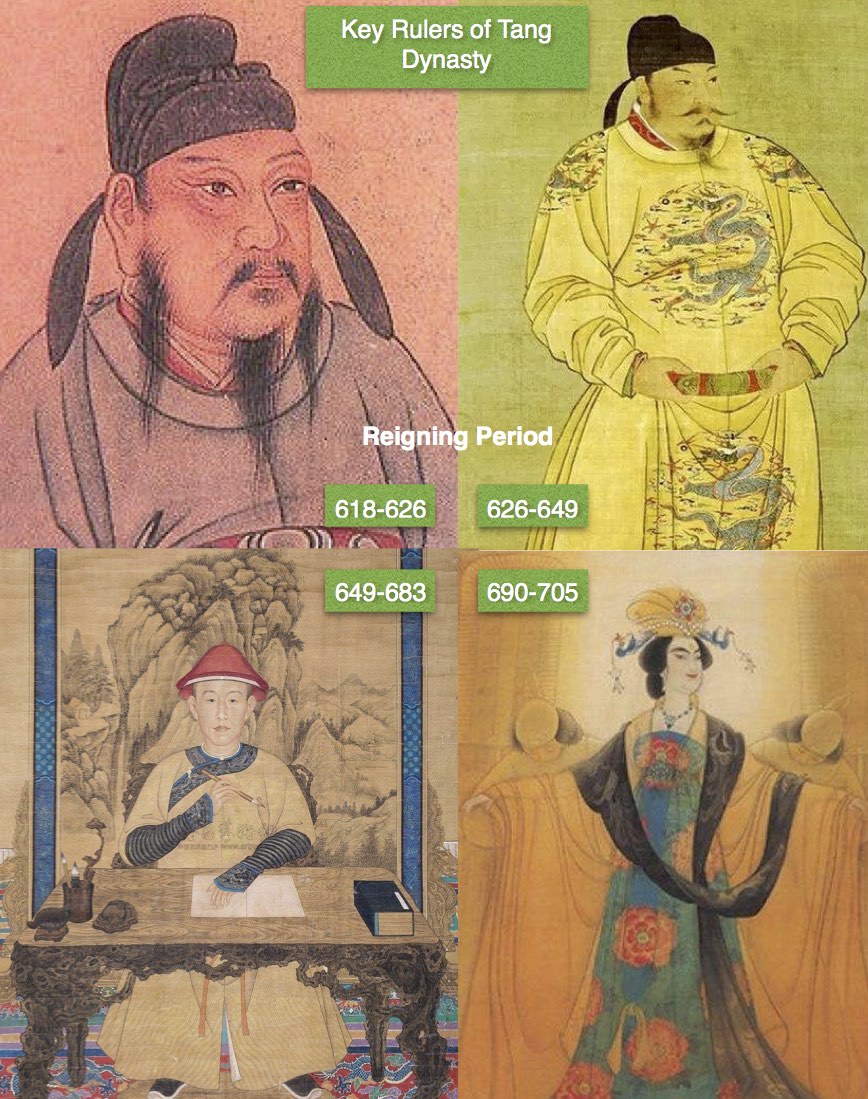The Tang Dynasty was one of the best era's the Chinese ever had. The economy was prosperous, the military was powerful, and art & culture was flourishing.
The farmers produced far more than the Chinese needed. Goods such as grains, rice, silk and spices where exported to nearby countries such India and Persia. The trade route known as the 'Silk Road', played an important role on this. Due to the unity and peace during the Tang period, it was possible to ship goods safely and trade started to develop between China and many other countries. But there wasn't only the trading of goods. New ideas and inventions were also exchanged along the trading routes.

From a cultural perspective, it was a golden time for Tang Dynasty pottery, ceramics, beautiful costumes and poems. Instead of practicing 'the art of war', rulers where interested in art and drinking good tea. One of the Tang Dynasty emperors instructed all poems to be collected, which impressively resulted in 84900 poems by 2300 poets. It was the best time for Chinese famous poets such as Li Bai and Du Fu to rise to fame.
All the goods and ideas came together in the capital of Chang'an ands spread through China. Tourist from all over the world visited the capital. It was at that time at the forefront of civilisation and received admiration from all over the world. The military was mighty as well expanding territory into the Korean Peninsula, Persia, Kazachstan and even Central Vietnam.
The Founder Of The Tang Dynasty: Gao Zu
The Tang Dynasty started in 618 when Yang Di, the last emperor of the Sui Dynasty died, and Li Yuan, the Duke of Tang, took the throne.
Li Yuan, also known as Gao Zu, couldn't wish for better conditions to start a dynasty. He benefited from the unification of China by the Sui, who also established a solid political system and standardised the currency. The Sui also reformed the 'equal-field system' to reduce economic inequality, thereby boosting productivity. The construction of the Grand Canal was a great achievement too, connecting the Eastern capital Luoyang with Chang'an, Hangzhou and even Beijing, allowing trade to prosper. This all was inherited from the Sui, so that Gao Zu only needed to refine the system that was in place.

Tang Dynasty Emperor Taizong
Gao Zu was an indecisive leader when it came to picking the crown prince. He'd three sons that fought to be the next emperor, and it was Li Shi Ming, who eliminated his two brothers in 626 and forced his father to crown him as the the next emperor. Thereafter, Li Shi Ming became known as 'Taizong'.
Taizong was one of the best emperors during the Tang Dynasty, and perhaps one of the best in Chinese Imperial history. During his reign from 626 to 649 he achieved great territorial expansion by taking Turkistan which is known today as 'Xin Jiang' (The New Frontier). He also strategically married his niche Wen Chang to the Songtsän Gampo, king of Tibet. The highly religious princess is credited by historians to have brought Buddhism to Tibet.
The succession of Taizong wasn't a smooth one. In 643, Li You rebelled against his father, but was pretty quickly captured by his subordinate Du Xingmin and sent to Chang'an. After Li You's downfall, the crown prince Li Chengqian feared that he would be replaced by Li Tai, and started a plot against his father. Lucky for Taizong it was Li Chengqian's own guard who revealed the prince's plans in order to save himself.
While at first Taizong believed that Li Tai was the most suitable after his two brothers where exiled, he later came to understand that actions of Li Chengqian was partly due to Li Tai's machinations. Therefore, he also exiled Li Tai. Eventually, it was the Li Zhi who took the throne and became emperor Gao Zhong.
Tang Dynasty Emperor Gaozong
After Gao Zu and Taizong, it was Lizhi's who became the third ruling emperor of the Tang Dynasty. Even though most historians see him as a weak ruler, his early achievements include the defeat of Eastern Tujue in 651 and Western Tujue in 657.
Perhaps, his perceived 'weak' character is also in part due the love affair he had with Wu Ze Tian, who used to be one of the concubines of his father. When Taizong passed away, they were reunited at the Ganyu temple when Li Zhi was offering incense. They directly fell in love again and the emperor would make her his concubine.
This started a whole plot behind the scenes of the kingdom. When Empress Wang and Consort Xiao lost favour they joined forces to take down Wu Ze Tian in 654, but without success. It was later that year when Wu Ze Tian gave birth to a daugther that soon after died. There's evidence that Empress Wang was the killer, but some historicans in fact believe it was Wu Ze Tian who killed her own daughter to frame empress Wang.
The momentum continued the year after, when Consort Wu accused the Empress and her mother of witchcraft. She got also more and more surrounded by officials who supported her. Eventually, Empress Wang was disposed and Wu Ze Tian took her spot next to the emperor. It's said that later in that year, Empress Wu killed Empress Wang after Gaozong was considering their release.
Gaozong stayed in power until 683, but after 665 it was mainly Wu Ze Tian that was in control.
The Rise Of Wu Ze Tian (Dowager Wu)
After Gaozong experienced a stroke in 660, it was Wu Zetian who became the administrator of the court, which was basically a postion equal to an emperor. Under her leadership, she helped China expand territorial borders by engaging in a war on the Korean Peninsula, and overpowered the resistance of the Goguryeo people.
After Taizong died in 683, his son Li Zhe became the next emperor Zhongzong. However, after just 6 weeks of reign, he was already dethroned, and replaced by Wu's third son Li Dan as 'Ruizong'. But Ruizong never really moved into the palace or had any significant power. In 690, Wu Ze Tian made her son announce that he would handover the throne to her and therfore becoming the first female ruler of China. As a result the Zhou Dynasty was established that shortly interupted the Tang.
Tang Dynasty Emperor Xuanzong
After Dowager Wu's reign it was in 712 When the Zhou Dynasty ended, as she announced her grandson Li Longji to be the next emperor known as Xuanzong.
With the start of Xuanzong's rule, historicans see this also as a start of one of China's most prosperous era's known as 'Kaiyuan' (713-741). The Kai Yuan era wasn't a time period to practice the art of war, instead it was a period of political stability, peace, prosperity as well as advances in art, music, literature and pleasure.
Concubine: Yang Gui Fei
Xuanzong was known to be an emperor with 1000s of concubines, but in his late reign it was Yang Yu Huan who he only cared about. He loved this woman against the advisors as she was first the wife of Li Mao, Xuanzong's 18th son. But Xuanzong insisted, and made Yang Yu Huan his concubine. She was so special to him that he created a new concubine rank called 'gui fei' for her and thereafter she was known by the name 'Yang Gui Fei'.
When she gained the Gui Fei distinction, she suggested Xuanzong to make her cousin Yang Guo Zhong the general of the army, instead of An Lushan.
An Lushan Rebellion
As the Yang family gained more power, the provocative actions on the An's resulted in the An Lushan rebellion that started in 755. In 756, the last major defense at the Tong Pass fell and the emperor had to flee towards Chengdu. Yang Guo Zhong was then killed by the imperial court in Ma Wei Yi and was blamed of treason and starting the An Lushan rebellion. At the same location, Xuanzong was also pressured to execute Yang Gui Fei.
What's remarkable is that he took her to a shrine and have her strangled to death with a length of silk, instead of execution by sword.
Emperor Suzong
After 756, Xuanzong appointed his son Suzong to plan the attacked to take back Chang'an. Meanwhile, An Lushan was killed by his son An Qingxu. Soon after, Suzong recaptured Chang'an and ended the rebellion.
In 762, Emperor Xuanzong passed away and Suzong was so saddened by his death that his own illness also advanced. He therefore appointed his son Li Yu to rule in his name. It was only 13 days after Xuanzong's death that also Suzong passed away. His son Li Yu then became the official ruler Daizong.
The Era of 5 Dynasties & 10 Kingdoms
After the 750s, the Tang Dynasty started to fall. The new emperors after Xuanzong's death had little power and where more puppets of powerful officials and generals. This power struggle resulted in the fall of the Tang Dynasty in 907 and started the era known as 'Five Dynasties and Ten Kingdoms'. This era ended with the foundation of the Song Dynasty in 960.